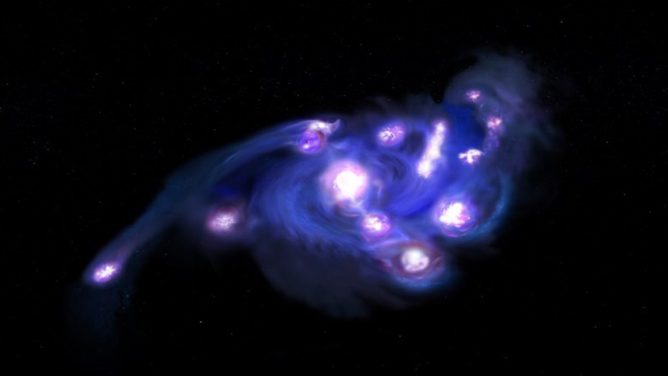Astronomers have used ALMA to detect a huge mass of glowing stardust in a galaxy seen when the Universe was only four percent of its present age. This galaxy was observed shortly after its formation and is the most distant galaxy in which dust has been detected. This observation is also the most distant detection of oxygen in the Universe. These new results provide brand-new insights into the birth and explosive deaths of the very first stars.
An international team of astronomers, led by Nicolas Laporte of University College London, have used the Atacama Large Millimeter/submillimeter Array (ALMA) to observe A2744_YD4, the youngest and most remote galaxy ever seen by ALMA. They were surprised to find that this youthful galaxy contained an abundance of interstellar dust—dust formed by the deaths of an earlier generation of stars.
Follow-up observations using the X-shooter instrument on ESO’s Very Large Telescope confirmed the enormous distance to A2744_YD4. The galaxy appears to us as it was when the Universe was only 600 million years old, during the period when the first stars and galaxies were forming ((This time corresponds to a redshift of z=8.38, during the epoch of reionisation.)).
Figure 1. This image is dominated by a spectacular view of the rich galaxy cluster Abell 2744 from the NASA/ESA Hubble Space Telescope. But, far beyond this cluster, and seen when the Universe was only about 600 million years old, is a very faint galaxy called A2744_YD4. New observations of this galaxy with ALMA, shown in red, have demonstrated that it is rich in dust.
Credit: ALMA (ESO/NAOJ/NRAO), NASA, ESA, ESO and D. Coe (STScI)/J. Merten (Heidelberg/Bologna)
“Not only is A2744_YD4 the most distant galaxy yet observed by ALMA,” comments Nicolas Laporte, “but the detection of so much dust indicates early supernovae must have already polluted this galaxy.”
Cosmic dust is mainly composed of silicon, carbon and aluminium, in grains as small as a millionth of a centimeter across. The chemical elements in these grains are forged inside stars and are scattered across the cosmos when the stars die, most spectacularly in supernova explosions, the final fate of short-lived, massive stars. Today, this dust is plentiful and is a key building block in the formation of stars, planets and complex molecules; but in the early Universe—before the first generations of stars died out—it was scarce.
The observations of the dusty galaxy A2744_YD4 were made possible because this galaxy lies behind a massive galaxy cluster called Abell 2744 ((Abell 2744 is a massive object, lying 3.5 billion light-years away (redshift 0.308), that is thought to be the result of four smaller galaxy clusters colliding. It has been nicknamed Pandora’s Cluster because of the many strange and different phenomena that were unleashed by the huge collision that occurred over a period of about 350 million years. The galaxies only make up five percent of the cluster’s mass, while dark matter makes up seventy-five percent, providing the massive gravitational influence necessary to bend and magnify the light of background galaxies. The remaining twenty percent of the total mass is thought to be in the form of hot gas.)). Because of a phenomenon called gravitational lensing, the cluster acted like a giant cosmic “telescope” to magnify the more distant A2744_YD4 by about 1.8 times, allowing the team to peer far back into the early Universe.
The ALMA observations also detected the glowing emission of ionised oxygen from A2744_YD4. This is the most distant, and hence earliest, detection of oxygen in the Universe, surpassing another ALMA result from 2016 ((See the press release issued on June 2016 titled “ALMA Detected the Most Distant Oxygen”.)).
The detection of dust in the early Universe provides new information on when the first supernovae exploded and hence the time when the first hot stars bathed the Universe in light. Determining the timing of this “cosmic dawn” is one of the holy grails of modern astronomy, and it can be indirectly probed through the study of early interstellar dust.
Figure 2. Artist’s impression of the very distant young galaxy A2744_YD4.
Credit: ESO/M. Kornmesser










